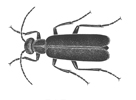|
With so many different insects, and with them occurring in so many
different places, it is no wonder that assigning common names is difficult and sometimes confusing. For example, the common name "stink bug" may be given to one insect in one part of the country and to a completely different insect in another part of the country. To reduce this confusion, a list of accepted common names has been developed by the Entomological Association of America. This list (Common names of Insects and Related Organisms 1997) includes many, but not all, common names.
An average person seldom uses scientific names, but refers to insects by common names such as "beetle," "blister beetle," or even "black blister beetle." In this example, the common name "beetle" may refer to any of thousands of insects belonging to the order Coleoptera. "Blister beetle," on the other hand, is a common name for all members of the family Meloidae, a subset of the order Coleoptera. "Black blister beetle" is the common name for Epicauta pennsylvanica, a particular species of insect. So, even though common names are very important and widely used, not all of them refer to individual insects. That is why standardized scientific names are necessary, especially to professional entomologists and insect collectors.
All insects belong to the class INSECTA. Within this class many
ORDERS of insects exist. This booklet describes how to classify the insects into one of 24 Orders. Within each order, many FAMILIES may exist. Within families, many GENERA occur and, likewise, within
Genera, many SPECIES exist. A general understanding of the scientific
nomenclature and rank order of associated names is important for
collectors. For example, in the blister beetle illustration below, a collector should know that the basic nomenclature is as follows:
Class = Insecta
Order = Coleoptera
Family = Meloidae
Genus = Epicauta
Species = pennsylvanica
All specimens in an insect collection should be identified at some level. Amateur collectors gain a good knowledge of insects by first classifying them according to their order name. An order is a name applied to a large group of insects having similar characteristics. For example, all butterflies and moths belong to the order Lepidoptera; all beetles, regardless of size, shape, or color, belong to the order Coleoptera; all flies belong to the order Diptera, and so forth.
In this book we will discuss the 24 orders listed here. Make a checklist of the insect orders you collect and display; it's a valuable organizing tool.
For professional entomologists and those who have sufficient interest, orders of insects can be further broken down. Orders are broken down into families, the families into genera, and the genera into species.
Professional entomologists generally study insects at the genus and
species level. The first word of an insect's scientific name is the genus to which it belongs, and the second word is the species name.
The Pictorial Key to the Order of Adult Insects included in this book should help you classify specimens to the order level. Similar keys exist for families, genera, and species separation, but are beyond the scope of this book. This book, as well as most field guides, also provides common names of the more frequently collected insects.
An insect collection check list is provided here for field collecting the insects required in this text.
|

